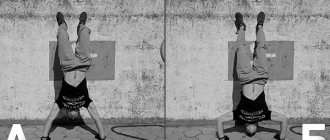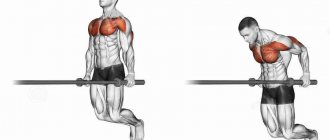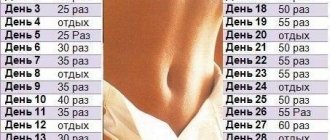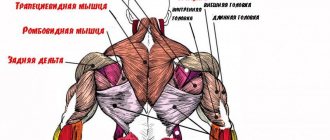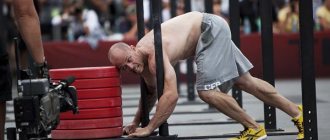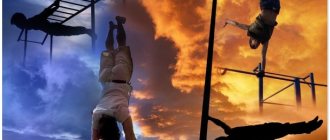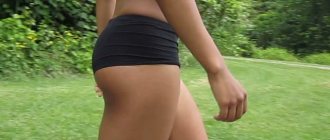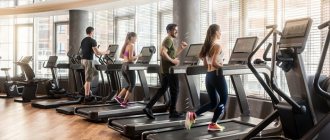The vast majority of exercises aimed at strengthening the muscles of the arms, in particular the biceps, involve the use of dumbbells or barbells with weights of various weights.
Professional fitness trainers, studying the topic of whether it is possible to achieve a similar result solely through pull-ups on the horizontal bar and uneven bars, came to the conclusion that such equipment is no less effective. However, only if you follow the recommendations of specialists in drawing up a training scheme, as well as with an integrated approach to the training itself.
The article below will tell you exactly how he can pump up his biceps on the horizontal bar or uneven bars, giving a description of the most effective exercises using these equipment.
Is it possible to build muscle with pull-ups, without weights or a gym?
Exercises using a horizontal bar and parallel bars are advisable for maintaining the shape of the biceps muscle corset, and not for forming it. Given the high intensity of such physical activity, increasing muscle mass is impossible without using weights or going to the gym.
In addition, the key to high-quality muscle growth is the gradual addition of weights as the muscles adapt to the existing load.
This is necessary due to the faster destruction of muscle fibers and their subsequent restoration (gain) during exercises with the actual working weight of the projectile for a particular athlete. If you work exclusively with your own weight, building muscle will be physically impossible.
Despite this, light pull-ups, in turn, are actively used to warm up muscles, as well as get rid of subcutaneous fat. Preliminary fat burning, especially in the arms, is of great importance for beginner athletes.
Important! Having started active training to increase muscle mass without drying the body, a person risks getting uneven definition or a significant increase in size. This is due to the fact that muscles will be formed under a layer of subcutaneous fat, while minimally affecting its elimination.
Be sure to check out:
How to pump up your biceps at home: strong and sculpted arms How to lift the barbell correctly to pump up your biceps Training your chest and biceps: a list of exercises and the nuances of pumping Intensive workouts for growing biceps and triceps
Types of grips on the horizontal bar and muscles worked
1. Straight grip
A narrow overhand grip works the shoulder muscles, serratus anterior, and lats.
The medium straight grip pumps up muscles such as the shoulder, pectoral and back muscles.
2. Reverse grip
A narrow reverse grip engages the biceps and lower lats.
A medium reverse grip helps develop the lats and biceps.
3. Wide grip
A wide grip in itself develops the latissimus muscles well. There are 2 types of pull-ups:
A wide grip to the chest develops the top of the latissimus muscles, trapezius, and round muscles.
Wide grip on the head – trapezoid, upper and middle lats, round.
4. Neutral grip
Neutral grip is a non-standard grip, but effective. It works the lower lats, triceps, brachialis, and serratus anterior.
Which equipment to prefer for exercises: crossbar or parallel bars?
When choosing between a horizontal bar and parallel bars for use in biceps training, you should focus on the athlete’s personal comfort and preferences.
The sports equipment under consideration are equivalent in their intensity and effect on the target area for transforming the arm muscles. Moreover, modern manufacturers of work-out equipment practice creating hybrid installations that combine both a crossbar and parallel bars.
This indicates the interchangeability of these devices and the pointlessness of choosing between them.
It is important to understand that achieving your goal and strengthening your biceps will require a long time and regular training. In view of this fact, it is worth preferring that equipment, classes with which will be possible at any time of the year, day, in any weather, and so on.
Important! In the case of planned training on the street, it is best for the horizontal bar or parallel bars to be located near the running track, since the absolute number of training schemes involves preliminary warming up of the muscles, including through cardio exercises (running, jumping, and so on).
Recommendations from professionals for organizing training
Vitaly Zimin, fitness trainer
Vitaly advises alternating strength training in the gym with work-out style exercises on horizontal bars or uneven bars. In his opinion, this approach will be most effective not only for strengthening the muscle corset, but also for creating relief in the arm muscles. It is important to follow the recommendations of a qualified trainer and adhere to the principles of a healthy lifestyle.
Maxim Torkin, fitness trainer
Maxim recommends including cardio exercises in complexes with exercises on horizontal bars or uneven bars. In his opinion, running would be ideal in such a case. It will help not only warm up the muscles and prepare the heart muscle for physical activity, but also accelerate metabolic processes that contribute to the growth of muscle mass, including in the biceps area.
Yulia Shcherbina, fitness bikini model
Julia does not advise beginner athletes to pump up their biceps using work-out equipment. In her opinion, exercises of this intensity should only be used by those who have already achieved certain results in transforming their own body and are currently looking for a way to stay in shape. By regularly performing this type of training, a beginner runs the risk of getting a serious injury (sprain, tear, rupture of ligaments) and achieving the opposite effect.
Training program
So, the program. The one that I have prepared for you is scheduled for a week and is perfect for both people who already have some training and for beginners. It includes exercises on the horizontal bar, parallel bars, press push-ups, that is, you can do absolutely everything on your own. Considering that bodyweight exercises are strength exercises, they are effective for gaining muscle mass, which you can accelerate and increase with proper, appropriate nutrition, as well as with the use of sports nutritional supplements, such as protein, for example. At the same time, such training is aimed at strength and endurance. In general, there are no cons.
Each training involves performing it in four approaches, each to the maximum. While doing the first 3, try to leave some resource for completing the next ones. Do the last, fourth, until you are completely exhausted.
If your training allows you to do 15 or more repetitions in each approach, then to gain muscle mass you need to add weights. It could even be a bag of sand, or you could hang a dumbbell or barbell plate from your belt or put it in your backpack, if you have one. If your goal is to work on relief, then weights are not needed, and the pace of execution should be extremely intense.
Naturally, for beginners, such a number of repetitions may seem impossible. Therefore, do as many as you can, and also increase the breaks between approaches. But try to work in the same mode: each exercise is performed in 4 approaches. Then you yourself will not notice how the number of your repetitions reaches the limit when additional loads are needed.
Believe me, the effectiveness and benefits of street training are even off the charts!
For my part, I offer you a program for a week, classes in which are supposed to be on Monday, Tuesday, Thursday and Friday, alternating between heavy workload and lighter workload. In principle, specific days are not necessary - the main thing is that you understand the principle and are not lazy. Let's get started?
TOP 5 exercises
The fastest results in strengthening your biceps using a horizontal bar can be achieved by performing the following exercises:
| Classic close grip pull-ups | Starting position (IP): grab the bar with a reverse grip, that is, placing the back of your hand towards you, your hands should not be far apart from each other (optimally - a little narrower than your shoulders), slightly bend your arms at the elbow joint, lift your legs off the floor and arrange them freely. Simultaneously with exhalation, it is necessary to pull the chest towards the horizontal bar, placing the chin above its crossbar. In the process of doing pull-ups, you should monitor the absence of deflections in the body and the tension of the muscle corset. Having fixed the resulting position for 2-3 seconds, inhale and slowly return to IP. |
| Partial pull-ups | IP: place your hands on the bar of the horizontal bar in the same way as before performing classic pull-ups, the distance between the hands should be equal to the distance between the shoulders, the shoulders should be lowered and straightened as much as possible, the crossed legs should be lifted off the surface and tucked under you. As you exhale, pull your body towards the bar, holding at half the amplitude of a full pull-up. At a pace, bring your chest closer to the horizontal bar and return it to the original half-fold the required number of times. Upon completion of the exercise, slowly return to the original position. |
| Classic medium grip pull-ups | IP: grab the bar with your palms facing you, your hands are spaced apart from each other at a distance slightly wider than between the athlete’s shoulders, cross your legs, lift them off the floor and tuck them underneath you. Take a deep breath. As you exhale, you need to pull your body towards the horizontal bar until the upper part of your chest touches it. Stay in this position for 3 seconds and slowly straighten your arms, taking the starting position. |
| Delayed pull-ups with straight grip | IP: grab the bar, positioning your hands so that the back of your palm is directed towards the horizontal bar, the distance between the hands is slightly greater than between the athlete’s shoulders, lift your legs off the ground and tuck them under you. As you exhale, pull your body towards the horizontal bar, touching the bar with your chest. Stay at the top point for 10 seconds, then slowly return to the IP. |
| Pull-ups with extra weight | Attach additional weight to the body, which can be a special vest, a weight or an iron plate (attached via a metal chain on the athlete’s belt or back). The IP and technique for correct execution depend on the type of pull-up chosen. |
Among the most effective exercises using parallel bars aimed at pumping up the biceps are the following:
| Diagonal pull-ups | Starting position (IP): grab the bars with your hands, rest your feet on the floor, placing your body at an angle diagonally. Make sure that in this position the entire body is one continuous line without bending in any area. After taking a deep breath and starting to exhale slowly, pull your body towards the bars, making sure that a solid line in the body is maintained even at the moment of pulling yourself up. Without pausing at the top point, return to the IP. After resting for no more than 1 second, resume pull-ups. |
| Reverse push-ups | IP: rest your hands on the surface of the bars, arms are straight, muscles are tense, legs are straight and located as close to each other as possible, the body is turned in the direction from the fastenings of the sports equipment. As you exhale, bend your arms at the elbow joint until a right angle is formed. After holding this position for 3 seconds, straighten your limbs, thus returning to the original position. |
| Pull-ups on parallel bars with weights | IP: rest your hands on the stable surface of the parallel bars, pre-fasten the working weight plate to your belt, straight back, legs crossed and slightly bent at the knees. Inhale deeply and begin to lower yourself down, bending your elbows and simultaneously releasing air from your lungs. After holding this position for 2-3 seconds, slowly pull the body with the weight up, trying to use exclusively the biceps. It is important to ensure that at the moment of straightening your arms there are no movements of the body, as well as deflections in it. Without taking long pauses at the top, repeat the exercise the required number of times. |
| Classic push-ups on wide bars | IP: rest your hands on the bars, your back is straight, your legs are bent and lifted off the floor. Making sure that your elbows are as far apart as possible, bend your arms, lowering your body as low as possible. Without pausing, slowly return to the IP. |
| Reverse grip half push-ups | The IP and exercise pattern are similar to reverse push-ups. The difference is that in this case the starting point for bending the arms is not a straight position of the arms, but a half-bent position. Returning the body from the lowest point should also be carried out in a half-bent position with the elbow joint. |
Monday
Monday is a hard day. Therefore, I also decided not to relax too much and do a harder lesson that day. As always, we start only after the warm-up.
- The first will be standard pull-ups, that is, a straight grip, hands shoulder-width apart;
- Next are the parallel bars - push-ups on the chest, that is, the torso is tilted forward a little, about 10 degrees, and in the process we move the elbows to the sides. But in the photo you can see the correct execution of this exercise;
- Again the horizontal bar - pull-ups behind the head, that is, hands about 2 shoulder-width apart, at the top point we touch the crossbar with the back of the head;
- We lie down on the floor and do regular push-ups, hands slightly wider than shoulder-width apart;
- Again the horizontal bar, but this time we work on the abs - we raise our legs while hanging;
- The last one is parallel bars, and also on the press. That is, on the uneven bars, we raise our legs - you can do it with straight arms, which is better, you can rest on your forearms.
Main conclusions
- To achieve the greatest effectiveness in pumping up your biceps with the help of a horizontal bar and parallel bars, you should use additional weights, and also alternate loads in the gym with work-out training.
- The crossbar and parallel bars are not only equivalent for strengthening arm muscles, but even interchangeable sports equipment.
- By following the advice of professional fitness trainers, as well as observing the correct technique for performing exercises on the horizontal bar and uneven bars, the athlete will be able to maintain a toned muscle corset for a long time.
Non-biceps exercises with a bar and parallel bars can be excellent helpers in achieving the desired result. However, it should be understood that their use in isolation from other types of physical activity, as well as ignoring additional weights, will reduce the effectiveness of the training.
What muscles swing on the uneven bars?
Which muscles work when doing dips depends on the version of the exercise.
In general, parallel bars allow you to train your triceps, shoulders and pectoral muscles. They also allow you to load your abdominal muscles.
The point of all parallel bars exercises is that you push your body with your hands against parallel bars in a vertical plane. Some skilled people are able to perform complex movements with their feet up, but this is more in the realm of gymnastics. Most people exercise in the usual position for everyone - feet down. We will analyze exactly the last case.
The variability of muscle work depends on the inclination of your body relative to the vertical and on the distance between the bars.
For example, let's take the triceps brachii muscle. The triceps makes up the bulk of the muscle volume of the arm above the elbow. About 70 percent. Therefore, this muscle will be mainly responsible for the volume of your arms. Push-ups will be very useful for working out your triceps. They noticeably increase the girth of the shoulder.
Try it yourself - a month before training, measure the volume of your triceps (arm straight). Consistently perform 3-4 sets of dips every 3 days. After a month (it turns out that about 10 training sessions will take place), repeat the measurements. Most likely, you will find a progress of at least 1 cm relative to the old volumes. This is how parallel bars affect the triceps.
Let's look at exercise options that focus on different muscle groups.
